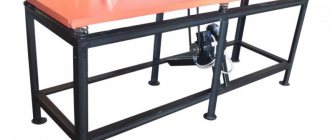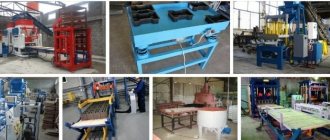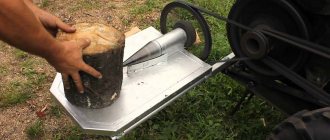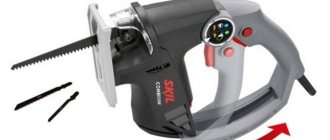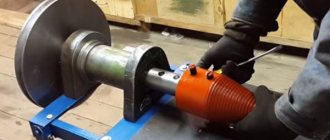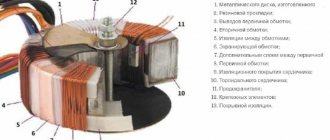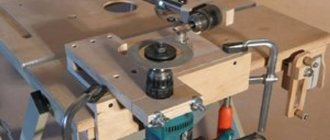Swinging an ax over a huge pile of firewood, you can’t help but think about how to make this hard labor easier.
A chainsaw is not an assistant here, since it is designed for cross-cutting wood. Only in a hopeless situation can it be used to loosen a board or timber. A thick wedge and a heavy hammer will help split a particularly hard and thick log, but this work cannot be called productive.
A screw firewood splitter - a simple and reliable device - will help you combine high speed wood chopping with minimal physical effort. Its operating principle is based on the ingeniously simple combination of a screw and a wedge.
An ordinary screw can be easily screwed into wood, but can only slightly push its fibers apart. But when a double-start persistent thread is applied to a steel cone, the desired result is achieved.
Expert advice! It is important to pay attention to the type of thread: a persistent two-start thread is required; if you use a single-start thread, you will have to forcefully push the log onto the carrot cone. Ask your sellers for a two-start thrust thread. Otherwise, when using a single-start thread, you will have to force the logs onto the screw cone with great effort!
Only the two-way cone is easily screwed into the log and, due to its wedge-shaped shape and persistent thread, splits it into two parts.
There are two main design schemes for cone splitters. In the first, the screw cone is installed directly on the shaft of a low-speed electric motor with a power of 3-5 kW (speed no more than 500).
Another option is implemented through the use of double-strand pulleys of different diameters and flexible drive belts. A small pulley is placed on the shaft of the electric motor, and a large pulley is placed on the shaft of the wood splitter screw.
The ratio of their diameters is selected so as to reduce the propeller speed compared to the engine speed by 2.5 - 4 times to 300-400 rpm.
The rotation speed of the cone screw can be reduced using a gear motor - a single unit in which the electric motor is structurally connected to a reduction gear. However, such models are not widely used in the market of screw axes.
Those who want to make such a machine with their own hands should remember that the high speed of rotation of the screw cone (more than 500 rpm) increases the risk of injury, since in this case it is difficult to hold the log in your hands.
In order to reduce the risk of injury to the machine, a stationary steel wedge is placed under the screw cone, which protects the log from jumping off.
Requirements for a cone splitter
A tool that is considered optimal for harvesting wood fuel must meet certain requirements. This applies to any of the existing types, hydraulic, mechanical and conical. The kone log splitter must have the following parameters for successful operation:
- working length (this is the name of the distance between the wedge and the piston, 50 cm is considered optimal);
- good splitting power (5-7 tons is considered standard), necessary for trouble-free splitting of the workpiece;
- sufficient rotation speed (at least 400 rpm, but not more than 600) to apply directed force to the wood fibers;
- the second indicator of speed is the movement of the piston, which is usually done 4 cm/sec forward and 7.5 cm/sec in the opposite direction;
- the presence of a travel limiter, which simultaneously increases productivity and reduces energy consumption;
- quite powerful engine (about 3-4 kW);
- the form and functionality of the screw, where the minimum operating speed determines the performance of both an industrial and home-made device, in which the screw plays one of the determining roles.
Dimensions, power and maximum possible performance are three components of the price when purchasing a device manufactured in an industrial environment.
Fact! A small mechanical model can be purchased for 6 thousand rubles. The more powerful the engine, the breaking force and the performance, the more expensive the device. The price of a wood splitter-screw can reach from 20 thousand rubles*. up to 125 thousand rubles*. The last setting chops a 40 cm workpiece in 2 seconds.
Screw wood splitter diagram
Popular models
The most popular are compact hand-held models with a blade. They are safe and reliable to use and are also suitable for indoor use.
GREENWEEN GW-DR3-T
The tool is suitable for splitting large diameter logs. The body is made of steel and coated with an anti-corrosion substance. The maximum length of logs for work is 45 cm.
Advantages:
- Safety.
- Convenience.
Flaws:
- Rapid deformation and dullness of the blade.
- Expensive replacement parts.
Reviews
KOLUNDROV "X4"
A wood splitter with a stable base in the form of a flat ring and an upper limiter for the mobility of the log. Cross-shaped blades allow you to divide the log into 4 parts with one blow. The device is made of steel grade st-3 with eight-layer corrosion protection.
Advantages:
- Sustainability.
- Thoughtful structure.
- Light weight.
Flaw:
Significant limitation on log thickness.
Reviews
KOLUNDROV “With a half ring”
The device is distinguished by the absence of a restrictive ring, which allows it to split logs of different diameters. As a result of splitting, two logs are obtained.
Advantages:
No deficiencies were identified.
Reviews
KOLUNDROV “Standard”
The standard model of a wood splitter is made of high-quality steel with patina and anti-corrosion multi-layer coating.
Advantages:
- Compactness.
- Simple device.
- Possibility of splitting wood chips.
Flaws:
Doesn't handle very thick logs.
Reviews
KOLUNDROV “X4 Cross”
A manual device for splitting firewood, cutting it into 4 parts. It has an upper ring with a diameter of 20 cm, the structure is made of steel with a protective coating.
Advantages:
- Good blade sharpening.
- Reliability of the design.
Flaw:
Small diameter of the working area.
Reviews
GREENWEEN GW-DR4-T
The device for manual chopping of firewood copes with logs up to 45 cm in length, is light in weight, and has a high-quality coating.
Advantages:
- High quality.
- Safety.
Flaw:
Poor stability when working on the ground.
Reviews
KOLUNDROV "Economy"
A simple unit for harvesting firewood and wood chips, it does not have a ring to restrict the material. Equipped with 4 holes for fixing.
Advantages:
- Ease of use with crooked and knotty logs.
- Efficiency.
Flaw:
Weak emphasis for support.
Reviews
Characteristics of manual models of wood splitters
| Model | Weight, kg | Working position | Maximum diameter of logs, cm | Price, rub |
| GREENWEEN GW-DR3-T | 4,8 | Vertical | 40 | 4 178 |
| KOLUNDROV "X4" | 6,5 | Vertical | 18 | 6 169 |
| KOLUNDROV “With a half ring” | 5,2 | Vertical | 40 | 5 800 |
| KOLUNDROV “Standard” | 6,6 | Vertical | 18 | 5 150 |
| KOLUNDROV “X4 Cross” | 6 | Vertical | 18 | 4 730 |
| GREENWEEN GW-DR4-T | 5,7 | Vertical | 20 | 3 988 |
| KOLUNDROV "Economy" | 3,1 | Vertical | 40 | 4 029 |
How to choose?
The choice of tool is dictated by the following criteria:
- weight;
- material;
- dimensions of the ax;
- sharpening shape.
Selecting a tool that matches the physical characteristics of the worker is not the easiest task. If the cleaver is too light, it will be difficult to split massive fragments, and when working with a heavy tool, more physical effort will be spent, but at the same time it will be much easier to split heavy ingots.
It is also important that the ax handle is made of durable wood, which has “astringent” properties. The handle experiences significant load, so it must have the above qualities
A short handle is also not suitable - it is difficult to work with. Handles that are made of PVC or steel are not the best choice. Such axes are expensive, but working with such a tool is inconvenient. Such a tool will not be able to trim trunks soaked in moisture, the diameter of which is more than 25 cm. The ax handle gets stuck in such material quite often.
Thrifty owners, as a rule, use one of two types of axes: classic or wedge-shaped. The first type is convenient for handling freshly cut wood, which contains a lot of moisture. The second type is convenient for splitting dry trimmings of logs.
Cone axes are easy to use and quite effective (especially when working with massive pieces of wood). The pig is installed perpendicularly, a screw is driven into it, then it splits. The work is simply mechanical.
The hydraulic drive helps in solving production problems - it makes it possible to separate logs immediately.
Hit or push?
Splitting wood chips is considered a dangerous production process: a blank that turns out of the machine can flatten a person, and flying wood chips can pierce him through. It is impossible to completely exclude emergency situations when chopping wild wood - in this regard, it is far from a completely predictable material. As a result, some types of technical classification of devices for splitting raw wood need to be kept in mind in order to make a wood splitter that is safe enough for everyday use. Namely, whether it is a shock action or a pressure action:
- Mechanized impact splitters with intermediate energy storage are highly efficient, economical, and almost completely relieve the operator of muscular effort, but they are structurally complex and the most dangerous in operation. They cope with any kind of fools, incl. with butt ridges of elm and larch.
- The same, manual ones without a mechanical energy accumulator - non-volatile, cheap, and structurally simple. They can be used in pressure mode and thus split twisted and knotted wood up to 25-30 cm in length. They require less muscular effort, and work safety is higher than when manually chopping with a cleaver on a block. Low productivity; suitable for irregular and occasional preparation of firewood.
- Push splitters driven by an internal combustion engine or an electric motor are quite expensive (see below). Also, the muscular efforts of the operator are almost completely eliminated. The productivity is sufficient to regularly supply firewood to a house of up to 200-300 sq. m in winter with frosts down to –40 and below. The highest possible security is achievable for this class of devices. Disadvantages are the complexity of the design and fairly high energy consumption in the form of electricity or liquid fuel.
Why - don't hit
In mechanical impact wood splitters, a relatively weak engine spins the flywheel through a fluid coupling. Thus, the engine operates almost all the time at optimal speed and consumes a minimum of fuel/electricity. Then a crank with a pusher is engaged with the flywheel (hydraulic or frictional), feeding the block to the splitting knife. The impact force is colossal: more energy can be “pumped” into a flywheel with a diameter of 60-80 cm than in a 100 kg aerial bomb. Churak actually does not split, but is cut with a knife, despite any defects in the wood.
Abroad, where energy resources and high-quality straight-layer wood are expensive, household mechanical impact wood splitters are produced and are in demand, see photo at the beginning. There are no imports of such devices into the Russian Federation, and industrial ones are finalizing their resources and analogues to replace them are not being developed. The reason is that they are extremely dangerous. Modern composite superflywheels do not burst, but it is impossible to stop the push from the flywheel and thereby prevent the development of an emergency situation into a threatening and dangerous one. Therefore, further in the article mechanical impact wood splitters with energy storage are not considered.
Assembly of the structure
Of the two types discussed above, the easiest to implement is the screw wood splitter. This is a simple design without complicated components. It consists of an electric motor, a screw cone, several bearings, a shaft and a gearbox. By the way, the latter can be in the form of a chain belt drive and can be used as a factory unit with a gear drive.
As for the motor, the best option is an electric one, although you can also install a gasoline one if you are building a huge wood splitter. Remember that for a small machine you can take a motor from an unnecessary washing machine, which runs on a voltage of two hundred and twenty volts. Although it has low power, but by installing a high-quality gearbox, you can increase its power a couple of times
It is important to choose all the elements correctly. For example, you can put a small pulley on the motor shaft, and install a huge diameter pulley on the shaft on which the cone is placed.
And the more the difference between the diameters grows, the more powerful the device will be.
Do not forget! A very serious indicator is the rotation speed of the working tool. It should not be higher than 500 rpm. Therefore, you need to choose the right gearbox for the electric motor.
Bearing selection
Now about the selection of bearings. In principle, any can be suitable, the main thing is that the shaft created for them is suitable for the loads acting on it.
For small wood splitters, you can install a shaft with a diameter of 25 mm. Accordingly, bearings with an internal diameter that matches the external diameter of a certain shaft are purchased for it.
The bearings themselves are installed on the device in a special cast iron housing.
The housing can be separate for each bearing or one for two at once. You can buy a body from a craftsman, but it is better to purchase old designs, which can always be found at any scrap metal dump.
The bearings are secured to the frame using bolts. The frame itself at the installation site must be quite strong, therefore, it is in the mounting parts under the bearing housings that a metal profile (angle, channel) is placed, which is welded to the wood splitter frame by electric welding. The base of the machine itself is made of pipes or corners.
Cone
And the most important element of a screw device with a two hundred and twenty volt motor is the cone. Let's start with the fact that it is created from very strong tool steel. Therefore, it is very difficult to create it yourself - even for a master - at home. But this is not worth doing, because screw cones are now sold freely. Remember that you need to choose the right size, because this determines which logs can be cut. Here is the relationship between the dimensions of the cone and the dimensions of the materials being cut for one tool length:
- diameter - seventy mm, bevel size - 1.1. With the specified characteristics, the splitting depth will be approximately 450 mm;
- diameter - eighty mm, bevel - 1.2, split depth - 550 mm;
- diameter - one hundred mm, bevel - 1.5, splitting depth - 750 mm.
Great attention should be paid to the direction of thread cutting. She should be left
That is, when installed, the cone should rest against the log and also pull it towards itself. In fact, with the help of a thread, an auxiliary movement of the part is produced - translational. It turns out that the working element itself will rotate.
This is quite important for domestic type cone log splitters, because they will not have a special feed unit. Everything will be done manually
It is this option that will provide conditions under which it will not be necessary to apply enormous pressure to the wood block being cut.
The choice of cone will depend on its design. There are only two types:
- with shank;
- with an internal special hole.
In the first option, in the shaft on which the cone will be placed, a hole is drilled from the end to accommodate the dimensions and diameter of the shank. The final one is inserted into the hole in the shaft and secured in it using a locking screw, which is installed on one side. In the second option, the shaft itself is inserted into the mounting hole of the cone, where it is secured with two locking screws.
Screw splitter
What is needed for making
Making an “iron lumberjack” does not require the use of scarce parts, so most components and blanks can be found at home or in the garages of friends and acquaintances. Here's what you'll need during the process:
- cone (you can grind the screw yourself or purchase it on the construction market);
- shaft (if you make your own threaded wedge, you can use a suitable hub from agricultural machinery);
- pulleys or sprockets;
- drive belt or chain from automobile or motorcycle equipment;
- bearings with housings (supports for car driveshafts are an excellent option);
- steel profile pipes or angles for the frame;
- metal sheet with a thickness of at least 4 mm for the desktop;
- electric motor;
- wiring;
- switch or magnetic starter;
- RCD;
- bolts and nuts M8 or M10.
Most parts can be used from old automobile or agricultural equipment . The only thing that may be difficult is making a cone screw. However, you should not even try to cut this part using a grinder, as some “authoritative” sources advise. The time spent is not worth the resulting misunderstanding, which can only indirectly be called a screw. Moreover, in operation this “carrot” will not even come one iota close to the efficiency that a cone made by turning will give.
Main components of a cone log splitter
If you plan to use the wood splitter as a mobile unit, then you should take care of durable metal wheels in advance. A truly mobile design is achieved using a gasoline or diesel engine as a power plant.
When making a machine, you will need tools that any “handy” owner will have:
- welding machine;
- electric drill with a set of drills;
- Bulgarian;
- hammer;
- set of wrenches;
- tape measure, marker.
Any enamel for exterior use is suitable for protection against corrosion. It is only important to thoroughly prepare the metal surface for painting, so if necessary, prepare a metal brush (manual, or in the form of an attachment for a drill or grinder), a primer and a rust converter.
Storing logs
When all the firewood is split, they need to be put in a woodpile. A typical mistake of many summer residents and rural residents is that they dump ready-made firewood in a pile. This cannot be done, because a shaky structure can quickly fall apart if at least one log lies poorly. But the most important thing is that firewood piled up does not dry well, which means it can become infected with fungus and mold.
You need to stack firewood carefully, in much the same way as children, when playing, stack construction blocks. Logs, beautifully stacked in a woodpile, look impressive and make a pleasant impression on the neighbors in the country. They are also convenient to take out when you need to bring a few logs home. Firewood should only be stored under a special canopy to prevent rain from falling on it. If they are located outdoors, the wood should be covered from rain with a tarpaulin or plastic film.
People who buy firewood based on an advertisement often complain about the dampness of the delivered wood. In this case, the logs should be dried immediately and only then stacked in a neat stack.
If one of the logs has a wood-boring beetle or other parasite, such a log should be immediately sent to the stove. Parasites are dangerous because they gradually destroy the wood and also make the wood more vulnerable to fungus and mold. Periodically, the logs need to be inspected and checked in what condition they are, and if they are folded beautifully and neatly, this will not be difficult at all.
Splitting firewood with a homemade cleaver is not as difficult as it seems. The main thing is that the ax is comfortable and sharp enough. There is a common misconception that using a sharp ax can easily injure yourself. In fact, lumberjacks most often get injured precisely because the cleaver is not sharpened well enough. By making an ax with your own hands and adapting it “for yourself,” a summer resident or villager will be able to significantly facilitate the annual work of preparing fuel for a Russian stove. This is much simpler and cheaper than buying expensive equipment or purchasing someone else’s firewood of dubious quality.
https://youtube.com/watch?v=m8NCJckjMZI
Owners of country cottages, who heat their homes using a solid fuel boiler or stove, annually prepare up to 12 cubic meters of firewood, depending on needs. It will take several days to prepare such a volume. To speed up the process, you can make your own cleaver - a special device for mechanized chopping of wood.
Operating principle of screw axes
A cone wood splitter, or as they are also called a screw splitter, has a simple operating principle. The cone, pointed on one side, rotates, which allows it to enter the wood like a screw and split it into pieces. Conical screw splitters are considered the simplest, most reliable and durable type of equipment. It is not surprising that, taking into account all the advantages of machines of this type, they have gained the greatest popularity today and are successfully used by summer residents and owners of private houses.
Tips for choosing
A manual wood splitter is suitable for small volumes of firewood. They are convenient for preparing the ignition for the barbecue or sauna
The device will also be relevant in places where there is no access to the electrical network or other types of power. For long-term work, it is important to choose a unit with an adjustable bed so that you can set the optimal height. In this case, you can do the work even while sitting on a stool. Another important parameter is the size of the material that will be processed by the device
In most cases, a model with a permissible log length of 50 cm is quite sufficient.
If you plan to split thick lumps, then it is better to give preference to devices without a ring stop. A good addition would be special protection for the blade from accidental blows with a sledgehammer during chopping. It is worth paying attention to models with a strong, stable base. It is better if it is wide, especially when you plan to use the unit at home and you don’t want to spoil the floor with dents. It is preferable to buy products from trusted and well-known companies that can provide warranty service and replacement of the device in case of defects or broken parts.
It is preferable to buy products from trusted and well-known companies that can provide warranty service and replacement of the device in case of defective or broken parts.
Spray bottle with water
The fourth drawing I wanted to share was autumn leaves painted using watercolors.
Having collected several leaves of maple, oak and a few others on the street, I scattered them beautifully on whatman paper and traced them with a pencil. After that, I generously moistened the leaf with water from a spray bottle, let it soak for 5 minutes and carefully blotted the pencil lines with a waffle towel. Watercolor, without diluting with water, was applied to whatman paper and sprinkled with salt. I chose tones from white to purple, but avoided all the leaves for now.
Be careful not to trespass. The first thing I did was just the background. I left it to dry, sprinkled with salt.
I chose tones from white to purple, but avoided all the leaves for now.
Be careful not to trespass. The first thing I did was just the background.
I left it to dry, sprinkled with salt.
Then I brushed off the salt with a dry brush. I made the leaves similarly to the background, but without salt. After drying, I drew all the veins and darkened the edges. I dipped my brush into white gouache and tapped it over the drawing, adding white flies, signs of late autumn and winter.

